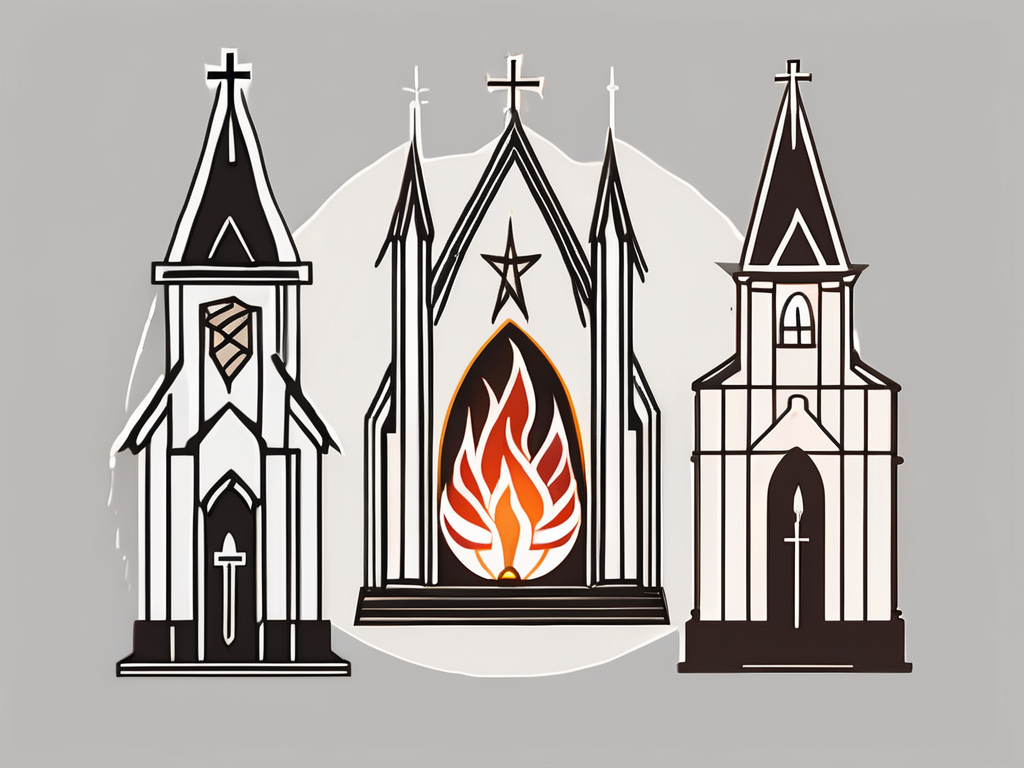In the world of Christianity, there are numerous denominations with their unique set of beliefs and practices. Two such denominations that often spark curiosity and debate are Pentecostalism and Lutheranism. While both share a common foundation in Christianity, they stand apart in several aspects. This article aims to provide a comparative analysis of Pentecostalism and Lutheranism, shedding light on their beliefs, historical context, worship styles, theological differences and similarities, as well as their societal impact and community involvement.
Understanding the Basics of Pentecostal and Lutheran Beliefs
Before delving into the intricate details, it is essential to have a solid understanding of the core beliefs that form the foundation of Pentecostalism and Lutheranism.
Pentecostalism and Lutheranism are two distinct Christian denominations that have their own unique beliefs and practices. While they both share a belief in Jesus Christ as the savior, there are significant differences in how they interpret and understand various aspects of the Christian faith.
The Core Beliefs of Pentecostalism
Pentecostalism emphasizes a personal and transformative relationship with God, often referred to as a “born-again” experience. Followers believe in the power and presence of the Holy Spirit, often manifesting in spiritual gifts such as speaking in tongues, prophecy, and divine healing. The Bible holds the utmost authority, and salvation is attained through faith and accepting Jesus Christ as the savior.
In Pentecostalism, the experience of being filled with the Holy Spirit is seen as a crucial aspect of the Christian journey. This experience, known as “baptism in the Holy Spirit,” is believed to empower individuals with spiritual gifts and enable them to live a life that is pleasing to God. Pentecostals believe that these spiritual gifts are not limited to the apostolic era but are available to all believers today.
Another important aspect of Pentecostalism is the belief in divine healing. Pentecostals believe that God has the power to heal physical, emotional, and spiritual ailments. They often engage in prayer and laying on of hands to invoke God’s healing power.
The Fundamental Tenets of Lutheranism
Lutherans profess a belief in justification by faith alone, meaning that individuals are saved through faith in Jesus Christ rather than through good works or human effort. This belief is central to Lutheranism and sets it apart from other Christian denominations.
Lutherans also emphasize the importance of the Bible as the ultimate source of authority. They believe that the Bible contains all the necessary teachings for salvation and that it should be read and interpreted by individuals with the guidance of the Holy Spirit.
In Lutheranism, the sacraments play a significant role in the spiritual life of believers. Baptism is seen as a means of grace, where individuals are cleansed of their sins and initiated into the Christian community. The Eucharist, also known as the Lord’s Supper, is seen as a sacrament of remembrance and thanksgiving for the sacrifice of Jesus Christ.
Furthermore, Lutherans believe in the priesthood of all believers, which means that every Christian has direct access to God and can approach Him without the need for intermediaries. This belief emphasizes the individual’s personal relationship with God and the importance of personal faith.
Overall, while Pentecostalism and Lutheranism share a common belief in Jesus Christ as the savior, they differ in their emphasis on the Holy Spirit, spiritual gifts, and the role of good works in salvation. Understanding these core beliefs is essential for gaining a deeper appreciation of the rich diversity within the Christian faith.
The Historical Context of Pentecostal and Lutheran Churches
Examining the historical context provides valuable insight into the origins and development of Pentecostalism and Lutheranism.
Understanding the historical context of religious movements allows us to appreciate the factors that contributed to their formation and growth. In the case of Pentecostalism and Lutheranism, both emerged during significant periods of religious and social change.
The Origins and Growth of Pentecostalism
Pentecostalism traces its roots to the early 20th century, where there was a notable surge in evangelical fervor, particularly in the United States. This period, known as the “Great Awakening,” witnessed a widespread spiritual revival that sought to reinvigorate Christianity.
One of the key events in the birth of the Pentecostal movement was the Azusa Street Revival, which took place in Los Angeles, California, from 1906 to 1909. Led by an African-American preacher named William J. Seymour, this revival attracted a diverse group of believers who sought a deeper experience of the Holy Spirit.
The Azusa Street Revival is considered a pivotal moment in the history of Pentecostalism, as it emphasized the practice of speaking in tongues, divine healing, and the belief in the imminent return of Jesus Christ. These teachings and experiences spread rapidly, leading to the establishment of numerous Pentecostal denominations and churches worldwide.
From its humble beginnings in Los Angeles, Pentecostalism quickly gained momentum and crossed cultural boundaries. Missionaries and evangelists carried the message of Pentecostalism to different parts of the world, resulting in the formation of vibrant Pentecostal communities in Africa, Asia, Latin America, and Europe.
The Reformation and Birth of Lutheranism
Lutheranism, on the other hand, emerged as a result of the Protestant Reformation in the 16th century. This period of religious upheaval was sparked by Martin Luther, a German monk who challenged certain practices and teachings of the Catholic Church.
Luther’s famous act of nailing his Ninety-Five Theses to the door of the Castle Church in Wittenberg, Germany, in 1517, marked the beginning of the Reformation. In his writings, Luther criticized the sale of indulgences, the authority of the Pope, and the doctrine of salvation through good works.
The ideas put forth by Luther resonated with many individuals who were disillusioned with the corruption and excesses of the Catholic Church. The Reformation quickly gained support, leading to the establishment of Protestant churches across Europe.
Lutheranism, named after Martin Luther, became one of the most influential branches of Protestantism. Luther’s writings, such as the “95 Theses” and his translation of the Bible into German, played a crucial role in shaping Lutheran theology and practice.
Central to Lutheran theology is the concept of “justification by faith alone,” which emphasizes that salvation is a gift of God’s grace and is received through faith in Jesus Christ. This belief challenged the Catholic Church’s teachings on the role of good works in attaining salvation.
Over time, Lutheranism spread throughout Europe, particularly in Germany and Scandinavia, where it became the dominant religious tradition. Lutheran churches were established, and their liturgical practices and hymnody became an integral part of the worship experience.
Today, both Pentecostalism and Lutheranism continue to thrive as distinct Christian traditions, each with its unique theological emphases and practices. The historical context in which these movements emerged provides a rich backdrop for understanding their development and impact on the religious landscape.
Worship Styles: Pentecostal vs Lutheran
Worship plays a central role in both Pentecostal and Lutheran churches. However, their approach and style differ significantly.
The Pentecostal Worship Experience
Pentecostal worship is often characterized by its energetic and spontaneous nature. Services involve lively music, passionate preaching, and a focus on personal spiritual encounters. The utilization of spiritual gifts, such as speaking in tongues or prophetic utterances, is not uncommon and can be seen as a direct interaction with the Holy Spirit.
Within the Pentecostal tradition, music holds a special place in worship. Congregants engage in vibrant and exuberant singing, accompanied by a full band or choir. The songs chosen are often contemporary and upbeat, designed to create an atmosphere of celebration and joy. The lyrics are deeply rooted in biblical teachings and aim to inspire and uplift the worshippers.
In addition to music, prayer is a fundamental aspect of Pentecostal worship. Congregants are encouraged to pray fervently, both individually and collectively, seeking a deeper connection with God. The prayers are often spontaneous and heartfelt, allowing individuals to express their personal needs and desires to the Lord.
Another distinctive feature of Pentecostal worship is the emphasis on the Holy Spirit’s presence and power. Believers believe in the baptism of the Holy Spirit, which is seen as a separate experience from salvation. This baptism is often accompanied by speaking in tongues, a spiritual gift that enables individuals to communicate with God in a language unknown to them. The practice of speaking in tongues is viewed as a direct manifestation of the Holy Spirit’s work in the believer’s life.
The Lutheran Approach to Worship
Lutheran worship follows a more structured and liturgical format. Congregations commonly experience hymn singing, traditional liturgies, and sacramental acts. The sermon holds great importance, focusing on biblical teachings and its relevance to the Christian life. Lutherans emphasize a sense of reverence and awe in their worship.
In Lutheran churches, hymns play a significant role in congregational worship. These hymns are carefully selected and often have deep theological meanings. The congregation sings together, accompanied by an organ or piano, creating a harmonious and reverent atmosphere. The hymns are chosen to reflect the theme of the service and to reinforce the teachings of the Bible.
Lutheran worship also includes liturgical elements, such as responsive readings, prayers, and creeds. These liturgical practices provide a sense of unity and continuity, connecting the congregation to the historical traditions of the Lutheran faith. The liturgy follows a prescribed order, allowing worshippers to participate in a structured and meaningful worship experience.
The sacraments hold a central place in Lutheran worship. Baptism and the Eucharist, or Holy Communion, are considered sacred acts that convey God’s grace to the believers. The sacraments are administered with reverence and solemnity, reminding the congregation of their participation in the life of Christ.
Furthermore, the sermon in Lutheran worship is a key component. The pastor delivers a carefully prepared message, drawing from the Bible and Lutheran theology. The sermon aims to provide guidance, encouragement, and instruction to the congregation, helping them apply the teachings of Scripture to their daily lives.
In conclusion, while both Pentecostal and Lutheran churches prioritize worship, their styles differ significantly. Pentecostal worship is characterized by its energetic and spontaneous nature, with a focus on personal spiritual encounters and the manifestation of spiritual gifts. On the other hand, Lutheran worship follows a more structured and liturgical format, emphasizing reverence, hymn singing, and sacramental acts. Both styles offer unique and meaningful worship experiences, catering to the diverse needs and preferences of worshippers.
Theological Differences and Similarities
Digging deeper into theology, there are notable differences and surprising similarities between Pentecostalism and Lutheranism.
Pentecostal and Lutheran Views on Salvation
While both denominations believe in salvation through faith in Jesus Christ, Pentecostals often emphasize a personal experience of being “born again” and filled with the Holy Spirit. Lutherans, on the other hand, stress that salvation is a gift from God and cannot be earned through works.
The Role of the Holy Spirit in Pentecostal and Lutheran Theology
The Holy Spirit holds a significant place in both Pentecostal and Lutheran theology. Pentecostals celebrate the ongoing work of the Holy Spirit in the lives of believers, emphasizing spiritual gifts and divine empowerment. Lutherans acknowledge the Holy Spirit’s role in the life of a believer as well, particularly through the means of grace, such as baptism and the Eucharist.
Societal Impact and Community Involvement
Beyond their theological differences, both Pentecostalism and Lutheranism have made significant contributions to society through their involvement in various aspects of community life.
Pentecostalism’s Influence on Society
Pentecostalism has had a profound impact both within and beyond Christian circles. Its emphasis on individual spiritual transformation has led to engagement in social justice issues, humanitarian efforts, and community outreach programs. Pentecostals often highlight the importance of living out their faith and being a positive influence in their communities.
The Role of Lutheranism in Community Service
Lutherans have a rich tradition of community service and social engagement. Their commitment to serving the marginalized and promoting justice is evident in various charitable organizations, education initiatives, and advocacy for human rights. Lutherans often stress the importance of good works as a response to God’s grace.
Conclusion
As we conclude this comparative analysis, it becomes clear that while Pentecostalism and Lutheranism have distinct beliefs, worship styles, and theological nuances, they are rooted in a shared commitment to Christianity. Understanding these differences and similarities promotes dialogue, respect, and appreciation for the diversity within the Christian faith.
Whether one finds their spiritual home in Pentecostalism or Lutheranism, the importance lies in embracing the teachings of Christ and living out our faith, loving and serving others, and seeking unity amidst our denominational diversity.












